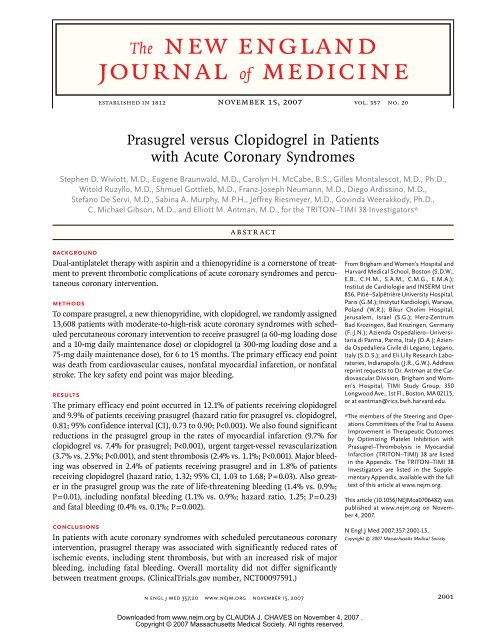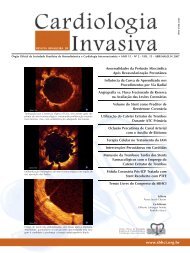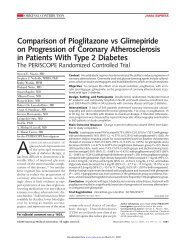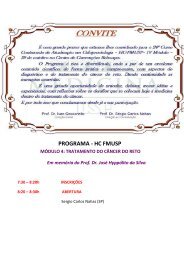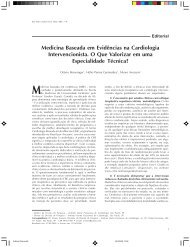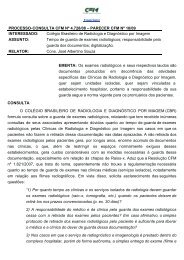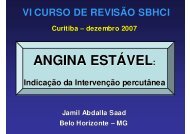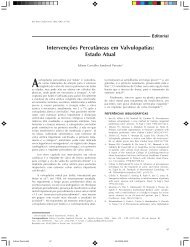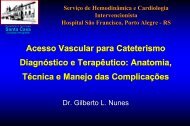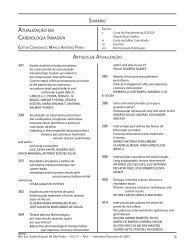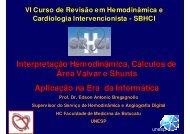The new england journal of medicine
The new england journal of medicine
The new england journal of medicine
You also want an ePaper? Increase the reach of your titles
YUMPU automatically turns print PDFs into web optimized ePapers that Google loves.
<strong>The</strong> <strong>new</strong> <strong>england</strong><br />
<strong>journal</strong> <strong>of</strong> <strong>medicine</strong><br />
established in 1812 november 15, 2007 vol. 357 no. 20<br />
Prasugrel versus Clopidogrel in Patients<br />
with Acute Coronary Syndromes<br />
Stephen D. Wiviott, M.D., Eugene Braunwald, M.D., Carolyn H. McCabe, B.S., Gilles Montalescot, M.D., Ph.D.,<br />
Witold Ruzyllo, M.D., Shmuel Gottlieb, M.D., Franz-Joseph Neumann, M.D., Diego Ardissino, M.D.,<br />
Stefano De Servi, M.D., Sabina A. Murphy, M.P.H., Jeffrey Riesmeyer, M.D., Govinda Weerakkody, Ph.D.,<br />
C. Michael Gibson, M.D., and Elliott M. Antman, M.D., for the TRITON–TIMI 38 Investigators*<br />
A bs tr ac t<br />
Background<br />
Dual-antiplatelet therapy with aspirin and a thienopyridine is a cornerstone <strong>of</strong> treatment<br />
to prevent thrombotic complications <strong>of</strong> acute coronary syndromes and percutaneous<br />
coronary intervention.<br />
Methods<br />
To compare prasugrel, a <strong>new</strong> thienopyridine, with clopidogrel, we randomly assigned<br />
13,608 patients with moderate-to-high-risk acute coronary syndromes with scheduled<br />
percutaneous coronary intervention to receive prasugrel (a 60-mg loading dose<br />
and a 10-mg daily maintenance dose) or clopidogrel (a 300-mg loading dose and a<br />
75-mg daily maintenance dose), for 6 to 15 months. <strong>The</strong> primary efficacy end point<br />
was death from cardiovascular causes, nonfatal myocardial infarction, or nonfatal<br />
stroke. <strong>The</strong> key safety end point was major bleeding.<br />
Results<br />
<strong>The</strong> primary efficacy end point occurred in 12.1% <strong>of</strong> patients receiving clopidogrel<br />
and 9.9% <strong>of</strong> patients receiving prasugrel (hazard ratio for prasugrel vs. clopidogrel,<br />
0.81; 95% confidence interval [CI], 0.73 to 0.90; P
T h e n e w e ng l a nd j o u r na l o f m e dic i n e<br />
<strong>The</strong> short-term and long-term benefits<br />
<strong>of</strong> dual-antiplatelet therapy with aspirin<br />
and clopidogrel have been established<br />
for patients with acute coronary syndromes 1-3 and<br />
those undergoing percutaneous coronary intervention<br />
(PCI). 4,5 Despite these benefits, many patients<br />
continue to have recurrent atherothrombotic events<br />
while receiving standard dual antiplatelet therapy. 1<br />
In addition, important limitations <strong>of</strong> clopidogrel<br />
remain, such as only a modest antiplatelet effect,<br />
with substantial interpatient variability 6,7 and a delayed<br />
onset <strong>of</strong> action. 5 Small clinical studies have<br />
suggested that patients with a reduced pharmacologic<br />
response to clopidogrel may be at increased<br />
risk for adverse clinical events, including myocardial<br />
infarction and coronary-stent thrombosis. 8-11<br />
Prasugrel — a novel thienopyridine — is a prodrug<br />
that, like clopidogrel, requires conversion to<br />
an active metabolite before binding to the platelet<br />
P2Y 12 receptor to confer antiplatelet activity. 12<br />
At the currently studied doses, prasugrel inhibits<br />
adenosine diphosphate–induced platelet aggregation<br />
more rapidly, more consistently, and to a<br />
greater extent than do standard and higher doses<br />
<strong>of</strong> clopidogrel in healthy volunteers 13 and in patients<br />
with coronary artery disease, 14,15 including<br />
those undergoing PCI. 16 Phase 2 testing <strong>of</strong> prasugrel,<br />
as compared with clopidogrel, in patients<br />
undergoing elective or urgent PCI showed a trend<br />
toward fewer ischemic events, with an acceptable<br />
safety pr<strong>of</strong>ile. 17 Thus, we designed the Trial to Assess<br />
Improvement in <strong>The</strong>rapeutic Outcomes by<br />
Optimizing Platelet Inhibition with Prasugrel–<br />
Thrombolysis in Myocardial Infarction (TRITON–<br />
TIMI) 38, a phase 3 trial involving patients with<br />
acute coronary syndromes with scheduled PCI,<br />
comparing a regimen <strong>of</strong> prasugrel with the standard-dose<br />
regimen <strong>of</strong> clopidogrel approved by the<br />
Food and Drug Administration. 18 Although our<br />
trial was designed to compare regimens <strong>of</strong> prasugrel<br />
and clopidogrel, it also tests the hypothesis<br />
that the use <strong>of</strong> an agent producing a higher level<br />
<strong>of</strong> inhibition <strong>of</strong> adenosine diphosphate–induced<br />
platelet aggregation and a less-variable response<br />
than standard-dose clopidogrel reduces ischemic<br />
events.<br />
Me thods<br />
TRITON–TIMI 38 was designed as a collaboration<br />
between the TIMI Study Group, the sponsors —<br />
Daiichi Sankyo and Eli Lilly — and a steering<br />
committee <strong>of</strong> investigators (see the Appendix).<br />
Quintiles Corporation provided data- and site-management<br />
services. All key prespecified and exploratory<br />
analyses were performed by the TIMI Study<br />
Group, using an independent copy <strong>of</strong> the complete<br />
database. <strong>The</strong> academic authors wrote all drafts <strong>of</strong><br />
the manuscript and vouch for the veracity and completeness<br />
<strong>of</strong> its content. <strong>The</strong> database was locked<br />
on September 22, 2007; the analyses reported herein<br />
were completed on October 26, 2007.<br />
Study Population<br />
We enrolled 13,608 patients with acute coronary<br />
syndromes (representative <strong>of</strong> the entire spectrum<br />
<strong>of</strong> those syndromes) with scheduled PCI. Patients<br />
were randomly assigned to the clopidogrel group<br />
or the prasugrel group in two strata: 10,074 patients<br />
with moderate-to-high-risk unstable angina<br />
or non–ST-elevation myocardial infarction and<br />
3534 patients with ST-elevation myocardial infarction.<br />
<strong>The</strong> inclusion criteria for patients with unstable<br />
angina or non–ST-elevation myocardial<br />
infarction were ischemic symptoms lasting 10<br />
minutes or more and occurring within 72 hours<br />
before randomization, a TIMI risk score 19 <strong>of</strong> 3 or<br />
more, and either ST-segment deviation <strong>of</strong> 1 mm<br />
or more or elevated levels <strong>of</strong> a cardiac biomarker<br />
<strong>of</strong> necrosis. Patients with ST-elevation myocardial<br />
infarction could be enrolled within 12 hours after<br />
the onset <strong>of</strong> symptoms if primary PCI was planned<br />
or within 14 days after receiving medical treatment<br />
for ST-elevation myocardial infarction. 18<br />
Full exclusion criteria have been published previously.<br />
18 Key exclusion criteria included an increased<br />
risk <strong>of</strong> bleeding, anemia, thrombocytopenia,<br />
a history <strong>of</strong> pathologic intracranial findings,<br />
or the use <strong>of</strong> any thienopyridine within 5 days<br />
before enrollment. 18 <strong>The</strong> protocol was approved<br />
by the institutional review boards associated with<br />
all participating centers, and written informed<br />
consent was provided by all patients.<br />
Study Protocol<br />
A loading dose <strong>of</strong> study medication (60 mg <strong>of</strong> prasugrel<br />
or 300 mg <strong>of</strong> clopidogrel) was administered,<br />
in a double-blind manner, anytime between randomization<br />
and 1 hour after leaving the cardiac<br />
catheterization laboratory. Since the protocol was<br />
designed as a trial <strong>of</strong> patients with acute coronary<br />
syndromes who were undergoing PCI, the coronary<br />
anatomy had to be known to be suitable for<br />
PCI before randomization in all patients with unstable<br />
angina or non–ST-elevation myocardial infarction,<br />
or in those enrolled after medical treat-<br />
2002<br />
n engl j med 357;20 www.nejm.org november 15, 2007<br />
Downloaded from www.nejm.org by CLAUDIA J. CHAVES on November 4, 2007 .<br />
Copyright © 2007 Massachusetts Medical Society. All rights reserved.
Pr asugrel vs. Clopidogrel in Patients with Acute Coronary Syndromes<br />
ment for ST-elevation myocardial infarction. If the<br />
coronary anatomy was previously known or primary<br />
PCI for ST-elevation myocardial infarction<br />
was planned, pretreatment with the study drug was<br />
permitted for up to 24 hours before PCI. Randomization<br />
was to occur before PCI was performed,<br />
and the study drug was to be administered as soon<br />
as possible after randomization.<br />
<strong>The</strong> choice <strong>of</strong> vessels treated, devices used, and<br />
adjunctive medication administered to support PCI<br />
was left to the discretion <strong>of</strong> the treating physician.<br />
After PCI, patients received maintenance doses<br />
<strong>of</strong> either prasugrel (10 mg) or clopidogrel (75 mg)<br />
daily. Use <strong>of</strong> aspirin was required, and a daily dose<br />
<strong>of</strong> 75 to 162 mg was recommended. Study visits<br />
were conducted at hospital discharge, at 30 days,<br />
at 90 days, and at 3-month intervals thereafter,<br />
for a total <strong>of</strong> 6 to 15 months. 18<br />
End Points<br />
<strong>The</strong> primary efficacy end point was a composite<br />
<strong>of</strong> the rate <strong>of</strong> death from cardiovascular causes,<br />
nonfatal myocardial infarction, or nonfatal stroke<br />
during the follow-up period. Key secondary end<br />
points at 30 and 90 days were the primary composite<br />
end point and a composite <strong>of</strong> death from<br />
cardiovascular causes, nonfatal myocardial infarction,<br />
or urgent target-vessel revascularization. Key<br />
secondary end points for the entire follow-up period<br />
were stent thrombosis and a composite <strong>of</strong><br />
death from cardiovascular causes, nonfatal myocardial<br />
infarction, nonfatal stroke, or rehospitalization<br />
due to a cardiac ischemic event. Additional<br />
prespecified analyses included an analysis <strong>of</strong> the<br />
rates <strong>of</strong> the primary end point from randomization<br />
to day 3 and a landmark analysis <strong>of</strong> those data<br />
from day 3 to the end <strong>of</strong> the study. Key safety end<br />
points were TIMI major bleeding not related to<br />
coronary-artery bypass grafting (CABG), non–<br />
CABG-related TIMI life-threatening bleeding, and<br />
TIMI major or minor bleeding, as previously defined.<br />
18 Stent thrombosis was defined as definite<br />
or probable stent thrombosis according to the<br />
Academic Research Consortium. 20 All components<br />
<strong>of</strong> the primary, secondary, and key safety end points<br />
were adjudicated by members <strong>of</strong> an independent<br />
clinical events committee that was unaware <strong>of</strong> the<br />
group assignments.<br />
Statistical Analysis<br />
Efficacy comparisons were performed on the basis<br />
<strong>of</strong> the time to the first event, according to the<br />
intention-to-treat principle. Safety analyses were<br />
carried out on data from patients who received at<br />
least one dose <strong>of</strong> the study drug. <strong>The</strong> Gehan–Wilcoxon<br />
test was used to compare the treatment<br />
groups with regard to the primary efficacy end<br />
point 18 ; the log-rank test was used in a prespecified<br />
sensitivity analysis for the primary end point<br />
and in all analyses <strong>of</strong> key secondary and safety end<br />
points. Because <strong>of</strong> the substantial overlap between<br />
the cohort <strong>of</strong> patients with unstable angina or non–<br />
ST-elevation myocardial infarction and the overall<br />
population <strong>of</strong> patients with acute coronary syndromes,<br />
and to preserve the statistical power to<br />
detect a difference between the two treatment<br />
groups, we used a closed testing procedure. <strong>The</strong><br />
primary efficacy end point was analyzed in the<br />
cohort with unstable angina or non–ST-elevation<br />
myocardial infarction first, and only if there was<br />
a statistically significant difference between the<br />
treatment groups was this end point analyzed in<br />
the overall cohort. 18 Rates <strong>of</strong> the end points are<br />
expressed as Kaplan–Meier estimates at 15 months<br />
and were compared with the use <strong>of</strong> hazard ratios<br />
and two-sided 95% confidence intervals. An independent<br />
data monitoring committee monitored<br />
the safety and efficacy <strong>of</strong> the study drugs. P values<br />
<strong>of</strong> less than 0.05 were considered to indicate<br />
statistical significance.<br />
We calculated that a total <strong>of</strong> 875 primary end<br />
points would be required for the study to have a<br />
90% power to detect a 20% reduction in the relative<br />
risk <strong>of</strong> the primary end point among patients<br />
with unstable angina or non–ST-elevation myocardial<br />
infarction receiving prasugrel, as compared<br />
with clopidogrel. It was estimated that 9500 patients<br />
with unstable angina or non–ST-elevation<br />
myocardial infarction would need to be enrolled<br />
to achieve this number <strong>of</strong> end points. 18 A prespecified<br />
assessment conducted when 650 patients<br />
had had a primary end point found a slightly<br />
lower-than-expected aggregate rate <strong>of</strong> the end<br />
point, which led us to increase the number <strong>of</strong> patients<br />
in the cohort with unstable angina or non–<br />
ST-elevation myocardial infarction to approximately<br />
10,100. 18<br />
R esult s<br />
We randomly assigned 13,608 patients (10,074 with<br />
unstable angina or non–ST-elevation myocardial<br />
infarction and 3534 with ST-elevation myocardial<br />
infarction), from 707 sites in 30 countries, to a<br />
treatment group between November 2004 and January<br />
2007. <strong>The</strong> baseline characteristics were sim-<br />
n engl j med 357;20 www.nejm.org november 15, 2007 2003<br />
Downloaded from www.nejm.org by CLAUDIA J. CHAVES on November 4, 2007 .<br />
Copyright © 2007 Massachusetts Medical Society. All rights reserved.
T h e n e w e ng l a nd j o u r na l o f m e dic i n e<br />
ilar to those in contemporary studies <strong>of</strong> patients<br />
with acute coronary syndromes who were undergoing<br />
PCI and were well matched between the<br />
treatment groups (Table 1). <strong>The</strong> median duration<br />
<strong>of</strong> therapy was 14.5 months. A total <strong>of</strong> 14 patients<br />
(0.1%) were lost to follow-up.<br />
Nearly all patients (99%) had PCI at the time<br />
<strong>of</strong> randomization, 94% received at least one intracoronary<br />
stent, and 47% received at least one<br />
drug-eluting stent. <strong>The</strong> study drug was administered<br />
before the first coronary guidewire was<br />
placed in 25% <strong>of</strong> patients, after the first coronary<br />
guidewire was placed and during the PCI or<br />
within 1 hour after PCI in 74%, and more than<br />
1 hour after PCI in 1%.<br />
Efficacy End Points<br />
<strong>The</strong> rate <strong>of</strong> the primary efficacy end point was<br />
significantly reduced in favor <strong>of</strong> prasugrel among<br />
the patients with unstable angina or non–ST-elevation<br />
myocardial infarction (hazard ratio, 0.82; 95%<br />
confidence interval [CI], 0.73 to 0.93; P = 0.002);<br />
therefore, as prespecified, the analysis was also<br />
performed in the overall cohort <strong>of</strong> patients with<br />
acute coronary syndromes. A significant benefit<br />
<strong>of</strong> prasugrel was also observed in the ST-elevation<br />
myocardial infarction cohort alone (hazard ratio,<br />
0.79; 95% CI, 0.65 to 0.97; P = 0.02), and there<br />
was no significant interaction between treatment<br />
group and enrollment stratum (unstable angina<br />
or non–ST-elevation myocardial infarction vs. STelevation<br />
myocardial infarction).<br />
In the overall cohort, a total <strong>of</strong> 781 patients<br />
(12.1%) in the clopidogrel group had the primary<br />
end point, as compared with 643 patients (9.9%)<br />
in the prasugrel group (hazard ratio, 0.81; 95% CI,<br />
0.73 to 0.90; P
Pr asugrel vs. Clopidogrel in Patients with Acute Coronary Syndromes<br />
pitalization for ischemia (hazard ratio, 0.84; 95%<br />
CI, 0.76 to 0.92; P
T h e n e w e ng l a nd j o u r na l o f m e dic i n e<br />
Table 1. Baseline Characteristics <strong>of</strong> the Patients.*<br />
Characteristic<br />
Prasugrel<br />
(N = 6813)<br />
Clopidogrel<br />
(N = 6795)<br />
Unstable angina or NSTEMI (%) 74 74<br />
STEMI (%) 26 26<br />
Age<br />
Median (yr) 61 61<br />
25th percentile, 75th percentile (yr) 53, 69 53, 70<br />
≥75 yr (%) 13 13<br />
Female sex (%) 25 27<br />
BMI†<br />
Median 28 28<br />
25th percentile, 75th percentile 25, 31 25, 31<br />
White race (%)‡ 92 93<br />
Region <strong>of</strong> enrollment (%)<br />
North America 32 32<br />
Western Europe 26 26<br />
Eastern Europe 24 25<br />
Middle East, Africa, or Asia–Pacific region 14 14<br />
South America 4 4<br />
Medical history (%)<br />
Hypertension 64 64<br />
Hypercholesterolemia 56 56<br />
Diabetes mellitus 23 23<br />
Tobacco use 38 38<br />
Previous MI 18 18<br />
Previous CABG 8 7<br />
Creatinine clearance
Pr asugrel vs. Clopidogrel in Patients with Acute Coronary Syndromes<br />
Table 1. (Continued.)<br />
Characteristic<br />
Prasugrel<br />
(N = 6813)<br />
Clopidogrel<br />
(N = 6795)<br />
Pharmacotherapy during index hospitalization (%)<br />
ACE inhibitor or ARB 76 75<br />
Beta-blocker 88 88<br />
Statin 92 92<br />
Calcium-channel blocker 18 17<br />
Aspirin 99 99<br />
* Patients could have had more than one type <strong>of</strong> medical history, undergone more than one type <strong>of</strong> index procedure,<br />
or received more than one type <strong>of</strong> pharmacotherapy during index hospitalization. <strong>The</strong> percentage <strong>of</strong> female patients<br />
and the percentage <strong>of</strong> patients who received an angiotensin-converting–enzyme (ACE) inhibitor or angiotensin-receptor<br />
blocker (ARB) differed significantly between the prasugrel group and the clopidogrel group (P = 0.02 and P = 0.03,<br />
respectively). NSTEMI denotes non–ST-elevation myocardial infarction (MI), STEMI ST-elevation MI, CABG coronaryartery<br />
bypass grafting, PCI percutaneous coronary intervention, and LMWH low-molecular-weight heparin. Beta-blocker<br />
is defined as β-adrenergic–receptor antagonist, and statin is defined as hydroxymethylglutaryl–coenzyme A reductase<br />
inhibitor.<br />
† <strong>The</strong> body-mass index (BMI) is the weight in kilograms divided by the square <strong>of</strong> the height in meters.<br />
‡ Race was self-reported.<br />
§ Creatinine clearance was estimated with the use <strong>of</strong> the Cockcr<strong>of</strong>t–Gault formula.<br />
Administration <strong>of</strong> the study drug before PCI occurred before the first coronary guidewire was placed during the index<br />
PCI; administration during PCI occurred after the first coronary guidewire was placed or within 1 hour after the patient<br />
was taken from the cardiac catheterization laboratory; and administration after PCI occurred more than 1 hour after the<br />
patient was taken from the cardiac catheterization laboratory.<br />
rhage in six patients (2.3%) in the prasugrel group,<br />
as compared with none in the clopidogrel group<br />
(P = 0.02). As a result, there was a significant interaction<br />
between a history <strong>of</strong> cerebrovascular events<br />
and the degree <strong>of</strong> net clinical benefit <strong>of</strong> prasugrel<br />
as compared with clopidogrel (Table 4), indicating<br />
a significant harm from prasugrel among<br />
patients with a history <strong>of</strong> cerebrovascular events<br />
(518 patients), as compared with a significant benefit<br />
from prasugrel among patients without such<br />
a history (13,090 patients). <strong>The</strong>re was also a significant<br />
interaction between the presence or absence<br />
<strong>of</strong> any <strong>of</strong> these three risk factors and the<br />
degree <strong>of</strong> net clinical benefit for prasugrel as compared<br />
with clopidogrel (P = 0.006), though no significant<br />
harm was evident. Among patients without<br />
any <strong>of</strong> these three risk factors, there was<br />
greater efficacy with prasugrel (hazard ratio, 0.74;<br />
95% CI, 0.66 to 0.84; P
T h e n e w e ng l a nd j o u r na l o f m e dic i n e<br />
Table 2. Major Efficacy End Points in the Overall Cohort at 15 Months.*<br />
End Point<br />
Death from cardiovascular causes, nonfatal MI,<br />
or nonfatal stroke (primary end point)<br />
Prasugrel<br />
(N = 6813)<br />
Clopidogrel<br />
(N = 6795)<br />
no. <strong>of</strong> patients (%)<br />
Hazard Ratio<br />
for Prasugrel<br />
(95% CI) P Value†<br />
643 (9.9) 781 (12.1) 0.81 (0.73–0.90)
Pr asugrel vs. Clopidogrel in Patients with Acute Coronary Syndromes<br />
A<br />
15<br />
10<br />
Primary Efficacy End Point<br />
Clopidogrel<br />
12.1<br />
9.9<br />
↓ 138 Events<br />
Hazard ratio, 0.81;<br />
95% CI, 0.73–0.90;<br />
P
T h e n e w e ng l a nd j o u r na l o f m e dic i n e<br />
Baseline Characteristics<br />
Overall<br />
Hazard Ratio for<br />
Prasugrel Efficacy<br />
(95% CI)<br />
Total No.<br />
<strong>of</strong> Patients<br />
13,608<br />
Prasugrel Clopidogrel<br />
(%)<br />
9.9 12.1<br />
Reduction<br />
in Risk<br />
(%)<br />
19<br />
Unstable angina or non–ST-elevation MI<br />
ST-elevation MI<br />
Sex<br />
Male<br />
Female<br />
Age<br />
Pr asugrel vs. Clopidogrel in Patients with Acute Coronary Syndromes<br />
Table 3. Thrombolysis in Myocardial Infarction (TIMI) Bleeding End Points in the Overall Cohort at 15 Months.*<br />
End Point<br />
Non–CABG-related TIMI major bleeding<br />
(key safety end point)<br />
Prasugrel<br />
(N = 6741)<br />
no. <strong>of</strong> patients (%)<br />
Clopidogrel<br />
(N = 6716)<br />
Hazard Ratio<br />
for Prasugrel<br />
(95% CI) P Value<br />
146 (2.4) 111 (1.8) 1.32 (1.03–1.68) 0.03<br />
Related to instrumentation 45 (0.7) 38 (0.6) 1.18 (0.77–1.82) 0.45<br />
Spontaneous 92 (1.6) 61 (1.1) 1.51 (1.09–2.08) 0.01<br />
Related to trauma 9 (0.2) 12 (0.2) 0.75 (0.32–1.78) 0.51<br />
Life-threatening† 85 (1.4) 56 (0.9) 1.52 (1.08–2.13) 0.01<br />
Related to instrumentation 28 (0.5) 18 (0.3) 1.55 (0.86–2.81) 0.14<br />
Spontaneous 50 (0.9) 28 (0.5) 1.78 (1.12–2.83) 0.01<br />
Related to trauma 7 (0.1) 10 (0.2) 0.70 (0.27–1.84) 0.47<br />
Fatal‡ 21 (0.4) 5 (0.1) 4.19 (1.58–11.11) 0.002<br />
Nonfatal 64 (1.1) 51 (0.9) 1.25 (0.87–1.81) 0.23<br />
Intracranial 19 (0.3) 17 (0.3) 1.12 (0.58–2.15) 0.74<br />
Major or minor TIMI bleeding 303 (5.0) 231 (3.8) 1.31 (1.11–1.56) 0.002<br />
Bleeding requiring transfusion§ 244 (4.0) 182 (3.0) 1.34 (1.11–1.63)
T h e n e w e ng l a nd j o u r na l o f m e dic i n e<br />
Table 4. <strong>The</strong> Balance <strong>of</strong> Efficacy and Safety in Selected Subgroups.*<br />
End Point Prasugrel Clopidogrel<br />
History <strong>of</strong> stroke or TIA<br />
Death from cardiovascular causes, nonfatal MI,<br />
or nonfatal stroke (primary efficacy end<br />
point)<br />
no. <strong>of</strong> patients/total no. (%)<br />
Hazard Ratio<br />
for Prasugrel<br />
(95% CI) P Value<br />
47/262 (19.1) 35/256 (14.4) 1.37 (0.89–2.13) 0.15<br />
Non–CABG-related TIMI major bleeding 14/257 (5.0) 6/252 (2.9) 2.46 (0.94–6.42) 0.06<br />
Death from any cause, nonfatal MI, nonfatal<br />
stroke, or non–CABG-related nonfatal TIMI<br />
major bleeding<br />
No history <strong>of</strong> stroke or TIA<br />
Death from cardiovascular causes, nonfatal MI,<br />
or nonfatal stroke (primary efficacy end<br />
point)<br />
57/262 (23.0) 39/256 (16.0) 1.54 (1.02–2.32) 0.04<br />
P Value for<br />
Interaction†<br />
596/6551 (9.5) 746/6539 (12.0) 0.79 (0.71–0.88)
Pr asugrel vs. Clopidogrel in Patients with Acute Coronary Syndromes<br />
prasugrel therapy and clopidogrel therapy among<br />
patients treated with a thienopyridine at the time<br />
<strong>of</strong> the identification <strong>of</strong> coronary anatomy appropriate<br />
for PCI, rather than a comparison <strong>of</strong> routine<br />
pretreatment with either agent before diagnostic<br />
cardiac catheterization. A strategy <strong>of</strong><br />
clopidogrel loading when coronary anatomy is<br />
known is now used by many cardiologists because<br />
<strong>of</strong> concern about surgical bleeding if a patient<br />
receives clopidogrel and then (because <strong>of</strong> a finding<br />
on coronary angiography) goes on to undergo<br />
CABG. 25 Pharmacodynamic data have shown that<br />
the degree <strong>of</strong> inhibition <strong>of</strong> platelet aggregation<br />
achieved with prasugrel within 30 minutes after<br />
treatment is similar to the peak effect <strong>of</strong> clopidogrel<br />
6 hours after administration, suggesting<br />
that prolonged pretreatment may not be necessary<br />
for prasugrel to achieve its therapeutic effect. 13 <strong>The</strong><br />
more rapid onset <strong>of</strong> an antiplatelet effect with<br />
prasugrel than with clopidogrel may have played<br />
an important role in the efficacy benefit, an assertion<br />
supported by the reduction in the rate <strong>of</strong> early<br />
myocardial infarction (before day 3) (Fig. 1B), despite<br />
the lack <strong>of</strong> pretreatment. However, when<br />
considering only end points occurring after day 3<br />
(Fig. 1C), the time at which the use <strong>of</strong> each drug<br />
should have resulted in the steady-state inhibition<br />
<strong>of</strong> platelet aggregation, the significant reduction<br />
in the rate <strong>of</strong> ischemic end points persisted,<br />
suggesting a continued benefit <strong>of</strong> greater inhibition<br />
<strong>of</strong> platelet aggregation during maintenance<br />
therapy.<br />
Partly because <strong>of</strong> data reporting an improved<br />
inhibition <strong>of</strong> platelet aggregation, 33,34 many clinicians<br />
have adopted the use <strong>of</strong> a higher-thanstandard<br />
loading dose <strong>of</strong> clopidogrel in patients<br />
with PCI, a practice endorsed by guideline committees.<br />
35,36 <strong>The</strong> clinical-efficacy data supporting<br />
the use <strong>of</strong> such higher-dose clopidogrel have been<br />
from small studies and have been inconsistent. 37,38<br />
<strong>The</strong> use <strong>of</strong> prasugrel (60 mg) has been shown to<br />
result in a greater inhibition <strong>of</strong> platelet aggregation<br />
than the use <strong>of</strong> clopidogrel (600 mg) in patients<br />
with chronic coronary artery disease. 15 <strong>The</strong><br />
Prasugrel in Comparison to Clopidogrel for Inhibition<br />
<strong>of</strong> Platelet Activation and Aggregation<br />
(PRINCIPLE)–TIMI 44 trial 16 showed a markedly<br />
superior inhibition <strong>of</strong> platelet aggregation, with<br />
regard to multiple measures <strong>of</strong> platelet function,<br />
in patients who had undergone elective PCI and<br />
who had received the regimen <strong>of</strong> prasugrel used<br />
in our study as compared with a higher-than-standard<br />
dose regimen <strong>of</strong> clopidogrel (a 600-mg loading<br />
dose and a 150-mg maintenance dose) —<br />
though the PRINCIPLE–TIMI 44 trial was not<br />
powered to study clinical end points.<br />
In our study <strong>of</strong> a selected population with moderate-to-high-risk<br />
acute coronary syndromes, on<br />
average, for every 1000 patients treated with prasugrel<br />
as compared with clopidogrel at the doses<br />
studied, 23 myocardial infarctions were prevented,<br />
with an excess <strong>of</strong> six non–CABG-related TIMI major<br />
hemorrhages. <strong>The</strong> estimated number <strong>of</strong> patients<br />
needed to be treated with prasugrel at the<br />
dosage studied, as compared with standard-dose<br />
clopidogrel, to prevent one primary efficacy end<br />
point during a 15-month period was 46. <strong>The</strong> number<br />
<strong>of</strong> patients who would have to be treated to<br />
result in an excess non–CABG-related TIMI major<br />
hemorrhage was 167.<br />
Our data support the hypothesis that the greater<br />
inhibition <strong>of</strong> adenosine diphosphate–induced<br />
platelet aggregation by means <strong>of</strong> the tested regimen<br />
<strong>of</strong> prasugrel, a potent oral P2Y 12 inhibitor, is<br />
more effective at preventing ischemic events than<br />
is the inhibition conferred by a standard regimen<br />
<strong>of</strong> clopidogrel. However, this beneficial effect is<br />
accompanied by an increase in the rate <strong>of</strong> major<br />
bleeding. When considering the choice <strong>of</strong> antiplatelet<br />
regimens for the treatment <strong>of</strong> patients<br />
with acute coronary syndromes who are undergoing<br />
PCI, clinicians need to weigh the benefits<br />
and risks <strong>of</strong> intensive inhibition <strong>of</strong> platelet aggregation.<br />
Supported by research grants from Daiichi Sankyo and Eli<br />
Lilly.<br />
Drs. Wiviott and Braunwald, Ms. McCabe, Ms. Murphy, and<br />
Drs. Gibson and Antman report receiving research grants from<br />
Eli Lilly, Daiichi Sankyo, and San<strong>of</strong>i-Aventis. In addition, Dr.<br />
Wiviott reports receiving consulting fees or paid advisory board<br />
fees from San<strong>of</strong>i-Aventis and lecture fees from Eli Lilly and Daiichi<br />
Sankyo; Dr. Braunwald, consulting fees or paid advisory<br />
board fees from Daiichi Sankyo and San<strong>of</strong>i-Aventis and lecture<br />
fees from Eli Lilly and San<strong>of</strong>i-Aventis; Dr. Montalescot, consulting<br />
fees or paid advisory board fees, lecture fees, and research<br />
grants from Bristol-Myers Squibb, Eli Lilly, and San<strong>of</strong>i-Aventis;<br />
and Dr. Ruzyllo, lecture fees from Eli Lilly. Dr. Ardissino reports<br />
receiving consulting fees or paid advisory board fees from AstraZeneca,<br />
Daiichi Sankyo, Merck Sharp & Dohme, and San<strong>of</strong>i-<br />
Aventis; lecture fees from Merck Sharp & Dohme and San<strong>of</strong>i-<br />
Aventis; and research grants from AstraZeneca, GlaxoSmithKline,<br />
Merck Sharp & Dohme, San<strong>of</strong>i-Aventis, and Schering-Plough;<br />
and Dr. De Servi, consulting fees or paid advisory board fees<br />
from Eli Lilly, lecture fees from Eli Lilly and San<strong>of</strong>i-Aventis, and<br />
research grants from San<strong>of</strong>i-Aventis. Drs. Riesmeyer and Weerakkody<br />
report being employees <strong>of</strong> Eli Lilly and holding equity<br />
ownership or stock options therein. Dr. Gibson reports receiving<br />
lecture fees from Daiichi Sankyo, Eli Lilly, and San<strong>of</strong>i-Aventis;<br />
and Dr. Antman, consulting fees or paid advisory board fees<br />
from San<strong>of</strong>i-Aventis and lecture fees from Eli Lilly and San<strong>of</strong>i-<br />
Aventis. No other potential conflict <strong>of</strong> interest relevant to this<br />
article was reported.<br />
n engl j med 357;20 www.nejm.org november 15, 2007 2013<br />
Downloaded from www.nejm.org by CLAUDIA J. CHAVES on November 4, 2007 .<br />
Copyright © 2007 Massachusetts Medical Society. All rights reserved.
T h e n e w e ng l a nd j o u r na l o f m e dic i n e<br />
Appendix<br />
<strong>The</strong> members <strong>of</strong> the Operations and Steering Committees <strong>of</strong> the TRITON–TIMI 38 were as follows (with principal investigators at<br />
participating centers listed separately, in the Supplementary Appendix): TIMI Study Group, Brigham and Women’s Hospital, Boston: E.<br />
Braunwald (study chair), E.M. Antman (principal investigator), S.D. Wiviott (investigator), C.M. Gibson (investigator), C.H. McCabe<br />
(director), S.A. Murphy (lead biostatistician), J. Buros (biostatistician), S. McHale (project manager); Sponsors: Eli Lilly — J. Riesmeyer,<br />
J.A. Ware, G. Weerakkody, W. Macias, E. Moscarelli, J. Croaning; Daiichi Sankyo — J. Warmke, F. Plat, T. Bocanegra, J. Hanyok, C. Hsu;<br />
Data Coordinating Center (Quintiles): K. Long, D. White, S. Boyle; Steering Committee: all members <strong>of</strong> the TIMI Study Group and<br />
sponsor staff listed above; France — G. Montalescot (coprincipal investigator), P.G. Steg; Norway — L. Aaberge; Denmark — H.R. Anderson;<br />
Italy — D. Ardissino, S. De Servi; Australia — P. Aylward; Chile — R. Corbalan; South Africa — A. Dalby; Slovak Republic — V. Fridrich;<br />
United States — M. Furman, D. Kereiakes, N. Kleiman, J. Popma; Canada — S. Goodman; Israel — S. Gottlieb; Argentina — E. Gurfinkel;<br />
Austria — K. Huber; Hungary — M. Keltai; Spain — J. Lopez-Sendon; Switzerland — T. Luscher; Germany — F.-J. Neumann, A. Schomig;<br />
Brazil — J. Nicolau; Poland — W. Ruzyllo; Sweden — F. Schersten; Portugal — R. Seabra-Gomes; Iceland — A. Sigurdsson; Finland — M.<br />
Syvanne; Belgium — F. Van de Werf; the Netherlands — F. Verheugt; New Zealand — H. White; Czech Republic — P. Widimsky; United Kingdom<br />
— R. Wilcox; Data Monitoring Committee: D.O. Williams (chair); D. DeMets (statistician); C. Bode, S. King, U. Sigwart; Clinical Events<br />
Committee: B. Scirica (administrative chair), E. Awtry, C. Berger, S. Bernard, A. Desai, E. Gelfand, C. Ho, F. Jaffer, S. Kathiresan, D.<br />
Leeman, M. Link, W. Maisel, F. Ruberg, U. Tedrow, J. Vita, P. Zimetbaum.<br />
References<br />
1. <strong>The</strong> Clopidogrel in Unstable Angina<br />
to Prevent Recurrent Events Trial Investigators.<br />
Effects <strong>of</strong> clopidogrel in addition<br />
to aspirin in patients with acute coronary<br />
syndromes without ST-segment elevation.<br />
N Engl J Med 2001;345:494-502. [Errata,<br />
N Engl J Med 2001;345:1506, 1716.]<br />
2. Chen ZM, Jiang LX, Chen YP, et al. Addition<br />
<strong>of</strong> clopidogrel to aspirin in 45,852<br />
patients with acute myocardial infarction:<br />
randomised placebo-controlled trial. Lancet<br />
2005;366:1607-21.<br />
3. Sabatine MS, Cannon CP, Gibson CM,<br />
et al. Addition <strong>of</strong> clopidogrel to aspirin<br />
and fibrinolytic therapy for myocardial infarction<br />
with ST-segment elevation. N Engl<br />
J Med 2005;352:1179-89.<br />
4. Mehta SR, Yusuf S. Short- and longterm<br />
oral antiplatelet therapy in acute coronary<br />
syndromes and percutaneous coronary<br />
intervention. J Am Coll Cardiol 2003;<br />
41:Suppl S:79S-88S.<br />
5. Steinhubl SR, Berger PB, Mann JT III,<br />
et al. Early and sustained dual oral antiplatelet<br />
therapy following percutaneous<br />
coronary intervention: a randomized controlled<br />
trial. JAMA 2002;288:2411-20. [Erratum,<br />
JAMA 2003;289:987.]<br />
6. Gurbel PA, Bliden KP. Durability <strong>of</strong><br />
platelet inhibition by clopidogrel. Am J Cardiol<br />
2003;91:1123-5.<br />
7. Serebruany VL, Steinhubl SR, Berger<br />
PB, Malinin AI, Bhatt DL, Topol EJ. Variability<br />
in platelet responsiveness to clopidogrel<br />
among 544 individuals. J Am Coll<br />
Cardiol 2005;45:246-51.<br />
8. Buonamici P, Marcucci R, Migliorini<br />
A, et al. Impact <strong>of</strong> platelet reactivity after<br />
clopidogrel administration on drug-eluting<br />
stent thrombosis. J Am Coll Cardiol 2007;<br />
49:2312-7.<br />
9. Gurbel PA, Bliden KP, Samara W, et<br />
al. Clopidogrel effect on platelet reactivity<br />
in patients with stent thrombosis: results<br />
<strong>of</strong> the CREST Study. J Am Coll Cardiol<br />
2005;46:1827-32.<br />
10. Hochholzer W, Trenk D, Bestehorn<br />
HP, et al. Impact <strong>of</strong> the degree <strong>of</strong> periinterventional<br />
platelet inhibition after load-<br />
ing with clopidogrel on early clinical outcome<br />
<strong>of</strong> elective coronary stent placement.<br />
J Am Coll Cardiol 2006;48:1742-50.<br />
11. Matetzky S, Shenkman B, Guetta V, et<br />
al. Clopidogrel resistance is associated<br />
with increased risk <strong>of</strong> recurrent atherothrombotic<br />
events in patients with acute<br />
myocardial infarction. Circulation 2004;<br />
109:3171-5.<br />
12. Niitsu Y, Jakubowski JA, Sugidachi A,<br />
Asai F. Pharmacology <strong>of</strong> CS-747 (prasugrel,<br />
LY640315), a novel, potent antiplatelet agent<br />
with in vivo P2Y12 receptor antagonist activity.<br />
Semin Thromb Hemost 2005;31:<br />
184-94.<br />
13. Brandt JT, Payne CD, Wiviott SD, et al.<br />
A comparison <strong>of</strong> prasugrel and clopidogrel<br />
loading doses on platelet function:<br />
magnitude <strong>of</strong> platelet inhibition is related<br />
to active metabolite formation. Am Heart<br />
J 2007;153:66.e9-66.e16.<br />
14. Jernberg T, Payne CD, Winters KJ, et<br />
al. Prasugrel achieves greater inhibition <strong>of</strong><br />
platelet aggregation and a lower rate <strong>of</strong><br />
non-responders compared with clopidogrel<br />
in aspirin-treated patients with stable<br />
coronary artery disease. Eur Heart J 2006;<br />
27:1166-73.<br />
15. Varenhorst C, Braun O, James S, et al.<br />
Greater inhibition <strong>of</strong> platelet aggregation<br />
with prasugrel 60 mg loading dose compared<br />
with a clopidogrel 600 mg loading<br />
dose in aspirin-treated patients. Eur Heart<br />
J 2007;28:Suppl:189. abstract.<br />
16. Wiviott SD, Trenk D, Frelinger AL III,<br />
et al. Prasugrel compared to high loading<br />
and maintenance dose clopidogrel in patients<br />
with planned percutaneous coronary<br />
intervention: the PRINCIPLE-TIMI 44 trial.<br />
Circulation (in press).<br />
17. Wiviott SD, Antman EM, Winters KJ,<br />
et al. Randomized comparison <strong>of</strong> prasugrel<br />
(CS-747, LY640315), a novel thienopyridine<br />
P2Y12 antagonist, with clopidogrel in<br />
percutaneous coronary intervention: results<br />
<strong>of</strong> the Joint Utilization <strong>of</strong> Medications to<br />
Block Platelets Optimally (JUMBO)-TIMI<br />
26 trial. Circulation 2005;111:3366-73.<br />
18. Wiviott SD, Antman EM, Gibson CM,<br />
et al. Evaluation <strong>of</strong> prasugrel compared<br />
with clopidogrel in patients with acute<br />
coronary syndromes: design and rationale<br />
for the TRial to assess Improvement in<br />
<strong>The</strong>rapeutic Outcomes by optimizing platelet<br />
InhibitioN with prasugrel Thrombolysis<br />
In Myocardial Infarction 38 (TRITON-<br />
TIMI 38). Am Heart J 2006;152:627-35.<br />
19. Antman EM, Cohen M, Bernink PJ, et<br />
al. <strong>The</strong> TIMI risk score for unstable angina/non-ST<br />
elevation MI: a method for prognostication<br />
and therapeutic decision making.<br />
JAMA 2000;284:835-42.<br />
20. Mauri L, Hsieh W, Massaro JM, Ho<br />
KKL, D’Agostino R, Cutlip DE. Stent<br />
thrombosis in randomized clinical trials<br />
<strong>of</strong> drug-eluting stents. N Engl J Med 2007;<br />
356:1020-9.<br />
21. Antithrombotic Trialists’ Collaboration.<br />
Collaborative meta-analysis <strong>of</strong> randomised<br />
trials <strong>of</strong> antiplatelet therapy for<br />
prevention <strong>of</strong> death, myocardial infarction,<br />
and stroke in high risk patients. BMJ<br />
2002;324:71-86. [Erratum, BMJ 2002;324:<br />
141.]<br />
22. Randomised placebo-controlled trial<br />
<strong>of</strong> abciximab before and during coronary<br />
intervention in refractory unstable angina:<br />
the CAPTURE Study. Lancet 1997;349:1429-<br />
35. [Erratum, Lancet 1997;350:744.]<br />
23. <strong>The</strong> Platelet Receptor Inhibition in<br />
Ischemic Syndrome Management in Patients<br />
Limited by Unstable Signs and Symptoms<br />
(PRISM-PLUS) Study Investigators.<br />
Inhibition <strong>of</strong> the platelet glycoprotein IIb/<br />
IIIa receptor with tir<strong>of</strong>iban in unstable angina<br />
and non–Q-wave myocardial infarction.<br />
N Engl J Med 1998;338:1488-97. [Erratum,<br />
N Engl J Med 1998;339:415.]<br />
24. <strong>The</strong> PURSUIT Trial Investigators. Inhibition<br />
<strong>of</strong> platelet glycoprotein IIb/IIIa<br />
with eptifibatide in patients with acute<br />
coronary syndromes. N Engl J Med 1998;<br />
339:436-43.<br />
25. Fox KA, Mehta SR, Peters R, et al.<br />
Benefits and risks <strong>of</strong> the combination <strong>of</strong><br />
clopidogrel and aspirin in patients undergoing<br />
surgical revascularization for non-<br />
ST-elevation acute coronary syndrome: the<br />
2014<br />
n engl j med 357;20 www.nejm.org november 15, 2007<br />
Downloaded from www.nejm.org by CLAUDIA J. CHAVES on November 4, 2007 .<br />
Copyright © 2007 Massachusetts Medical Society. All rights reserved.
Pr asugrel vs. Clopidogrel in Patients with Acute Coronary Syndromes<br />
Clopidogrel in Unstable angina to prevent<br />
Recurrent ischemic Events (CURE) Trial.<br />
Circulation 2004;110:1202-8.<br />
26. Alexander KP, Chen AY, Roe MT, et al.<br />
Excess dosing <strong>of</strong> antiplatelet and antithrombin<br />
agents in the treatment <strong>of</strong> non-<br />
ST-segment elevation acute coronary syndromes.<br />
JAMA 2005;294:3108-16.<br />
27. Mahaffey KW, Harrington RA, Simoons<br />
ML, et al. Stroke in patients with<br />
acute coronary syndromes: incidence<br />
and outcomes in the platelet glycoprotein<br />
IIb/IIIa in unstable angina. Circulation<br />
1999;99:2371-7.<br />
28. Diener HC, Bogousslavsky J, Brass LM,<br />
et al. Aspirin and clopidogrel compared<br />
with clopidogrel alone after recent ischaemic<br />
stroke or transient ischaemic attack in<br />
high-risk patients (MATCH): randomised,<br />
double-blind, placebo-controlled trial. Lancet<br />
2004;364:331-7.<br />
29. Carey RJ. Warfarin-induced rectal<br />
bleeding as clue to colon cancer. Lancet<br />
1984;1:505-6.<br />
30. Jaffin BW, Bliss CM, LaMont JT. Significance<br />
<strong>of</strong> occult gastrointestinal bleeding<br />
during anticoagulation therapy. Am J<br />
Med 1987;83:269-72.<br />
31. Campbell CL, Smyth S, Montalescot<br />
G, Steinhubl SR. Aspirin dose for the prevention<br />
<strong>of</strong> cardiovascular disease: a systematic<br />
review. JAMA 2007;297:2018-24.<br />
32. Cannon CP. Learning from the recently<br />
completed oral glycoprotein IIb/IIIa receptor<br />
antagonist trials. Clin Cardiol 2000;<br />
23:Suppl 6:VI-14–VI-17.<br />
33. Montalescot G, Sideris G, Meuleman<br />
C, et al. A randomized comparison <strong>of</strong><br />
high clopidogrel loading doses in patients<br />
with non-ST-segment elevation acute coronary<br />
syndromes: the ALBION (Assessment<br />
<strong>of</strong> the Best Loading Dose <strong>of</strong> Clopidogrel<br />
to Blunt Platelet Activation, Inflammation<br />
and Ongoing Necrosis) trial. J Am Coll<br />
Cardiol 2006;48:931-8.<br />
34. von Beckerath N, Taubert D, Pogatsa-<br />
Murray G, Schömig E, Kastrati A, Schömig<br />
A. Absorption, metabolization, and antiplatelet<br />
effects <strong>of</strong> 300-, 600-, and 900-mg<br />
loading doses <strong>of</strong> clopidogrel: results <strong>of</strong><br />
the ISAR-CHOICE (Intracoronary Stenting<br />
and Antithrombotic Regimen: Choose Between<br />
3 High Oral Doses for Immediate<br />
Clopidogrel Effect) Trial. Circulation 2005;<br />
112:2946-50.<br />
35. Silber S, Albertsson P, Aviles FF, et al.<br />
Guidelines for percutaneous coronary interventions.<br />
Eur Heart J 2005;26:804-47.<br />
36. Smith SC Jr, Feldman TE, Hirshfeld<br />
JW Jr, et al. ACC/AHA/SCAI 2005 guideline<br />
update for percutaneous coronary intervention:<br />
a report <strong>of</strong> the American College<br />
<strong>of</strong> Cardiology/American Heart Association<br />
Task Force on Practice Guidelines<br />
(ACC/AHA/SCAI Writing Committee to<br />
Update 2001 Guidelines for Percutaneous<br />
Coronary Intervention). Circulation 2006;<br />
113:e166-e286.<br />
37. Patti G, Colonna G, Pasceri V, Pepe LL,<br />
Montinaro A, Di Sciascio G. Randomized<br />
trial <strong>of</strong> high loading dose <strong>of</strong> clopidogrel<br />
for reduction <strong>of</strong> periprocedural myocardial<br />
infarction in patients undergoing coronary<br />
intervention: results from the ARMYDA-2<br />
(Antiplatelet therapy for Reduction <strong>of</strong> Myocardial<br />
Damage during Angioplasty) study.<br />
Circulation 2005;111:2099-106.<br />
38. Wolfram RM, Torguson RL, Hassani<br />
SE, et al. Clopidogrel loading dose (300<br />
versus 600 mg) strategies for patients with<br />
stable angina pectoris subjected to percutaneous<br />
coronary intervention. Am J Cardiol<br />
2006;97:984-9.<br />
Copyright © 2007 Massachusetts Medical Society.<br />
posting presentations at medical meetings on the internet<br />
Posting an audio recording <strong>of</strong> an oral presentation at a medical meeting on the<br />
Internet, with selected slides from the presentation, will not be considered prior<br />
publication. This will allow students and physicians who are unable to attend the<br />
meeting to hear the presentation and view the slides. If there are any questions<br />
about this policy, authors should feel free to call the Journal’s Editorial Offices.<br />
n engl j med 357;20 www.nejm.org november 15, 2007 2015<br />
Downloaded from www.nejm.org by CLAUDIA J. CHAVES on November 4, 2007 .<br />
Copyright © 2007 Massachusetts Medical Society. All rights reserved.


